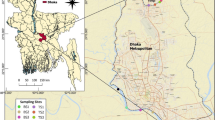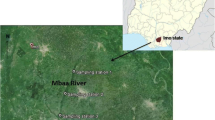Abstract
Accumulation of heavy metals in contaminated sediments and Sole fish, Euryglossa orientalis from Musa estuary were investigated. For this purpose, the sediments and fish samples were collected from 10 sampling sites with different of sources pollution and ecological condition around the Musa estuary. The samples were analyzed by a cold vapor Atomic Absorption Spectrometer Leco AMA-254. Based results, metals concentrations were ranged from 0.06 to 8.34 µg/g for Hg, 0.02 to 6.23 µg/g for MeHg, 0.75 to 16.38 µg/g for Pb, 22.04 to 79.42 µg/g for Ni, 24.98 to 77.51 µg/g for V and 0.05 to 0.93 µg/g for Cd in sediment, and from 0.69 to 7.23 μg/g for Hg, 0.67 to 4.87 μg/g for MeHg, 16.34 to 58.45 μg/g for Ni, 0.78 to 9.56 μg/g for Pb, 6.78 to 53.22 μg/g for V and from 0.08 to 9.56 μg/g for Cd in tissues of the fish samples in all sampling sites. Results showed there were significant differences in metals values between liver and gill of fish species (P<0.05), that metals value was higher in liver in compare the gill fish. The analyses of Pearson correlation showed there was positive correlation between sediment and fish for metals concentration (r = 0.955). Analyses of geoaccumulation index and enrichment factor showed there was high pollution with anthropogenic sources in more sampling sites.




Similar content being viewed by others
References
Abrahim GMS, Parker R, Nichol S (2007) Distribution and assessment of sediment toxicity in Tamaki Estuary, Auckland, New Zealand. Environ Geol 52(7):1315–1323
Afrifa CG, Ofosu FG, Bamford SA, Wordson DA, Atiemo SM, Aboh IJ, Adeti JP (2013) Heavy metal contamination in surface soil dust at selected fuel filling stations in Accra, Ghana. Am J Sci Ind Res 4:404–413
Agah H, Leermakers M, Elskens M, Fatemi SMR, Baeyens W (2009) Accumulation of trace metals in the muscle and liver tissues of five fish species from the Persian Gulf. Environ Monit Assess 157:499–514
Akporido SO, Ipeaiyeda AR (2014) An assessment of the oil and toxic heavy metal profiles of sediments of the Benin River adjacent to a lubricating oil producing factory, Delta State, Nigeria. Int Res J Public Environ Health 1(2):40–53
Aprile FM, Bouvy M (2008) Distribution and enrichment of heavy metals in sediments at the Tapacura River Basin, North eastern Brazil. Braz J Aqua Sci Tech 12(1):1–8
Barakat A, El Baghdadi M, Rais J, Nadem S (2012) Assessment of heavy metal in surface sediments of day river at Beni-MellalRegion, Morocco. Res J Environ Earth Sci 4(8):797–806
Bastami KD, Neyestani MR, Shemirani F, Soltani F, Haghparast S, Akbari A (2015) Heavy metal pollution assessment in relation to sediment properties in the coastal sediments of the southern Caspian Sea. Mar Pollut Bull 92:237–243
Barhoumi B, Clerandeau C, Landi L, Pichon A, Le Bihanic F, Poirier P, Anschutz P, Budzinski H, Driss MR, Cachot J (2016) Assessing the toxicity of sediments using the medaka embryo–larval assay and 2 other bioassays. Environ Toxicol Chem 35(9):2270–2280
Carr RS, Long ER, Windom HL, Chapman DC, Thursby G, Sloane GM, Wolfe DA (1996) Sediment quality assessment studies of Tampa Bay, Florida. Environ Toxicol Chem 15:1218e1231
Cherfi A, Cherfi M, Maache-Rezzoug Z, Rezzoug SA (2016) Risk assessment of heavy metals via consumption of vegetables collected from different supermarkets in La Rochelle. France. Environ Monit Assess 188(3):136. https://doi.org/10.1007/s10661-016-5140-7
Chen MH (2002) Baseline metal concentrations in sediments and fishes, and the determination of bioindicators in the subtropical Chi-ku Lagoon. S. W. Taiwan. Mar Pollut Bull 44:703–714
Darvish Bastami KD, Neyestani MR, Shemirani F, Soltani F, Haghparast S, Akbari A (2015) Heavy metal pollution assessment in relation to sediment properties in the coastal sediments of the southern Caspian Sea. Mar Pollut Bull 92:237–243
de Mora S, Fowler S, Wyse E, Azemard S (2004) Distribution of heavy metals in marine bivalves, fish and coastal sediments in Persian Gulf and Gulf of Oman. Mar Pollut Bull 49:410–424
El Nemr AM, El Sikaily A, Khaled A (2007) Total and Leachable Heavy Metals in Muddy and Sandy Sediments of Egyptian Coast Along Mediterranean Sea. Environ Monit Assess 129:151–168
Enuneku AA, Ezemonye LI, Ainerua MO (2014) Human health risk assessment of metal contamination through consumption of Sesarma angolense and Macrobrachium macrobrachion from Benin River. Nigeria. Eur I J Sci Technol 3(6):77–86
Enuneku A, Omoruyi O, Tongo I, Ogbomida E, Ogbeide O, Ezemonye L (2018) Evaluating the potential health risks of heavy metal pollution in sediment and selected benthic fauna of Benin River. Southern Nigeria. Appl Water Sci 8:224
FAO (Food and Agriculture Organization) (2011) Compilation of legal limits for hazardous substances in fish and fishery products. FAO Fishery Circular No. 464: 5–10. Food and Agriculture Organization of the United Nations, Rome
Hakanson L (1980) An ecological risk index for aquatic pollution control. a sedimentological approach. Water Res 14 (8): 975–1001
Hosseini M, Nabavi SMB, Parsa Y (2013) Bioaccumulation of mercury in trophic level of benthic, benthopelagic, pelagic fish species and sea bird from Arvand river, Iran. Biol Trace Elem Res. https://doi.org/10.1007/s12011-013-9841-2
Hosseini M, Nabavi SMB, Parsa Y, Saadatmand M (2014) Mercury contamination in some marine biota species from Khuzestan shore, Persian Gulf. Toxicol Ind Health. https://doi.org/10.1177/0748233714555392
Ibhadon S, Emere MC, Abdulsalami MS, Yilwa V (2014) Bioaccumulation of some trace metals in wild and farm-raised African Catfish Clarias gariepinus in Kaduna, Nigeria. Pak J Nutri 13(12):686–69
Jiao X, Teng Y, Zhan Y, Wu J, Lin X (2015) Soil heavy metal pollution and risk assessment in Shenyang industrial district, Northeast China. PLoS One 10(5):e0127736. https://doi.org/10.1371/journal.pone.0127736
Long ER, MacDonald DD (1998) Recommended uses of empirically derived, sediment quality guidelines for marine and estuarine ecosystems. Hum Ecol Risk Assess 4(5):1019–1039
Long ER, MacDonald DD, Smith SC, Calder FD (1995) Incidence of adverse biological effects within ranges of chemical concentrations in marine and estuarine sediments. Environ Manage 19(1):81–97
Luo W, Lu Y, Wang T, Hu W, Jiao W, Naile JE, Khim JS, Giesy JP (2010) Ecological risk assessment of arsenic and elements in sediments of coastal areas of Northern Bohai and Yellow Seas, China. Ambio 39:367–375
Karbassi A, Monavari SM, Bidhendi GRN, Nematpour K (2008) Metal pollution assessment of sediment and water in the Shur River. Environ Monit Assess 147:107–116
Karbassi AR, Fakhraee M, Heidari M, Vaezi AR, Valikhani Samani AR (2014) Dissolved and particulate trace metal geochemistry during mixing of Karganrud River with Caspian Sea water. Arab J Geosci 1–9
Keshavarzi B, Hassanaghaei M, Moore F, Rastegari Mehr M, Soltanian S, Lahijanzadeh AR, Sorooshian A (2018) Heavy metal contamination and health risk assessment in three commercial fish species in the Persian Gulf. Mar Pollut Bull 129(1):245–252. https://doi.org/10.1016/j.marpolbul.2018.02.032
MacDonald DD, Carr RS, Calder FD, Long ER, Ingersoll CG (1996) Development and evaluation of sediment quality guidelines for Florida coastal waters. Ecotoxicology 5: 253–278
Manoj K, Padhy PK (2014) Distribution, enrichment and ecological risk assessment of six elements in bed sediments of a tropical river, Chottanagpur Plateau: a spatial and temporal appraisal. J Environ Protect 5:1419–1434
Massaquoi LD, Ma H, Liu XH, Han PY, Zuo SM, Hua ZX, Liu DW (2015) Heavy metal accumulation in soils, plants, and hair samples: an assessment of heavy metal exposure risks from the consumption of vegetables grown on soils previously irrigated with wastewater. Environ Sci Pollut R. https://doi.org/10.1007/s11356-015-5131-1
Monikh FA, Safahieh AR, Savari A, Doraghi A (2012) Heavy metal concentration in sediment, benthic, benthopelagic, and pelagic fish species from Musa Estuary (Persian Gulf). Environ Monit Assess. https://doi.org/10.1007/s10661-012-2545-9
Muller G (1979) Schwermetalle in den sedimenten des Rheins e Vera¨nderungenseit 1971. Umschau 79:778–783
Nhiwatiwa T, Barson M, Harrison AP, Utete B, Cooper RG (2011) Metal concentrations in water, sediment and sharp tooth catfish Clarias gariepinus from three peri-urban rivers in the upper Manyame catchment, Zimbabwe. Afr J Aquat Sci 36:243–252
Ogoyi DO, Mwita CJ, Nguu EK, Shiundu PM (2011) Determination of heavy metal content in water, sediment and Microalgae from Lake Victoria, East Africa. Open Environ Eng J 4:156–161
Pejman AH, Nabi Bidhendi GR, Ardestani M, Saeedi M, Baghvand M, Moradi SH (2012) Assessment of Mineralogical Composition and Heavy Metal Pollution in the Surface Sediment of North West Persian Gulf. Int J Environ Res 4:1067–1074
Pourkerman M, Amjadi S, Naderi Beni A, Lahijani H, Mehdinia A (2017) Evaluation of metal contamination in the Mand River delta, Persian Gulf. Mar Pollut Bull 119(2). https://doi.org/10.1016/j.marpolbul.2017.05.003
Sarasiab AR, Hosseini M, Mirsalari Z (2014) Lead distribution in contaminated surface sediments from four estuaries, Khuzestan shore, north part of Persian Gulf. Bull Environ Contam Toxicol. https://doi.org/10.1007/s00128-014-1354-y
Rezaei A, Sayadi MH (2015) Long-term evolution of the composition of surface water from the River Gharasoo, Iran: a case study using multivariate statistical techniques. Environ Geochem Health 37:251–261
ROPME (1999) Regional report of the state of the marine environment. Regional Organization for the Protection of The Marine Environment (ROPME), Kuwait 220
Samani ARV, Karbassi AR, Fakhraee M, Heidari M, Vaezi AR, Valikhani Z (2014) Effect of dissolved organic carbon and salinity on flocculation process of heavy metals during mixing of the Navrud River water with Caspian Seawater. Desalination Water Treat 1–9
Soliman NF, Nasr SM, Okbah MA (2015) Potential ecological risk of heavy metals in sediments from the Mediterranean coast, Egypt. J Environ Health Sci Eng 13:70–81
Tang W, Zhang C, Zhao Y, Shan B, Song Z (2016) Pollution, toxicity, and ecological risk of heavy metals in surface river sediments of a large basin undergoing rapid economic development. Environ Chem. https://doi.org/10.1002/etc.3650
Turkmen A, Turkmen M, Tepe YI, Akyurt I (2005) Heavy metals in three commercially valuable fish species from Iskenderun Bay, Northern East Mediterranean Sea, Turkey. Food Chem 91:167–172
USEPA (1999) Screening Level Ecological Risk Assessment Protocol for Hazardous Waste Comustion Facilities. Appendix E: Toxicity Reference Values, vol. 3, USEPA, Washington, DC, USA
Vaezi AR, Karbassi AR, Fakhraee M (2015) Assessing the trace metal pollution in the sediments of Mahshahr Bay, Persian Gulf, via a novel pollution index. Environ Monit and Assess 187:613. https://doi.org/10.1007/s10661-015-4833-7
Wang J, Du H, Xu Y, Chen K, Liang J, Ke H, Cheng S, Liu M, Deng H, He T, Wang W, Cai M (2016) Environmental and Ecological Risk Assessment of trace metal contamination in mangrove ecosystems: a case from Zhangjiangkou Mangrove National Nature Reserve, China. BioMed Res Int. https://doi.org/10.1155/2016/2167053
WHO (1990) Methylmercury. Environmental Health Criteria Series, 101, pp 144, World Health Organization (WHO), Geneva, Switzerland
Yang Z, Lu W, Long Y, Bao X, Yang Q (2011) Assessment of heavy metals contamination in urban topsoil from Changchun City. China. J Geochem Explor 108(1):27–38
Zhang R, Zhou L, Zhang F, Ding YJ, Gao JR, Chen J, Yan HQ, Shao W (2013) Heavy metal pollution and assessment in the tidal flat sediments of Haizhou Bay, China. Mar Pollut Bull 74(7):403–441
Zsuzsanna S, Istvan C, Maria BO, Maria NA, Elena Z (2001) Trace metal levels in freshwater fish, sediment and water. Environ Sci Pollut Res 8(4):265–268
Acknowledgements
This work was funded by Zystab Sanaat of Persian Gulf Institute of Tehran, Iran.
Author information
Authors and Affiliations
Corresponding author
Additional information
Publisher's Note
Springer Nature remains neutral with regard to jurisdictional claims in published maps and institutional affiliations.
Rights and permissions
About this article
Cite this article
Abdolvand, S., Kaedinejadesfahani, S. Measurement of Some Heavy Metals in the Sediments and Sole Fish Euryglossa orientalis from the Musa Creek. Thalassas 38, 675–685 (2022). https://doi.org/10.1007/s41208-021-00328-x
Received:
Revised:
Accepted:
Published:
Issue Date:
DOI: https://doi.org/10.1007/s41208-021-00328-x




